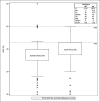A modified Timeline Followback assessment to capture alcohol exposure in pregnant women: Application in the Safe Passage Study
- PMID: 28755748
- PMCID: PMC5553051
- DOI: 10.1016/j.alcohol.2017.02.174
A modified Timeline Followback assessment to capture alcohol exposure in pregnant women: Application in the Safe Passage Study
Abstract
Prenatal alcohol exposure (PAE) has been linked to poor pregnancy outcomes, yet there is no recognized standard for PAE assessment, and the specific effects of quantity, frequency, and timing remain largely unknown. The Safe Passage Study was designed to investigate the role of PAE in a continuum of poor peri- and postnatal outcomes. The objective of this manuscript is to describe the rationale for, and feasibility of, modifications to the traditional Timeline Followback (TLFB) for collecting PAE information in a large cohort of pregnant women. Participants from the Northern Plains region (in the United States) and Cape Town, South Africa, were followed prospectively using a modified 30-day TLFB interview, administered up to five times, to obtain detailed PAE information. Required modifications for our population included capturing information regarding sharing, type/brand, container size, and duration, in order to accurately record the amount of alcohol consumed. PAE status was defined for 99.9% of the 11,892 enrolled pregnancies at least once during pregnancy and for 92% across all trimesters. Of 53,823 drinks reported, 98% had all items necessary for standard drink computation. Sharing was reported for 74% of drinks in Cape Town, South Africa and for 10% in the Northern Plains. Compared to referent values from the traditional TLFB, 74% and 67% of drinks had different alcohol-by-volume and container size, respectively. Furthermore, a statistically significant difference was found between the number of containers reported and the number of standard drinks computed, using information from the modified TLFB. This is the first study of this size to wholly encompass all of these changes into a single measure in order to more accurately calculate daily consumption and assess patterns over time. The methods used to collect PAE information and create alcohol exposure measures likely increased the accuracy of standard drinks reported and could be generalized to other populations.
Keywords: Prenatal alcohol exposure; Quantity-frequency methods; Self-report; Standard drink; Timeline followback (TLFB).
Copyright © 2017 Elsevier Inc. All rights reserved.
Conflict of interest statement
The authors report no conflicts of interest. The authors alone are responsible for the content and writing of the paper.
Figures



Similar articles
-
Association of Prenatal Exposure to Maternal Drinking and Smoking With the Risk of Stillbirth.JAMA Netw Open. 2021 Aug 2;4(8):e2121726. doi: 10.1001/jamanetworkopen.2021.21726. JAMA Netw Open. 2021. PMID: 34424306 Free PMC article.
-
You Didn't Drink During Pregnancy, Did You?Alcohol Clin Exp Res. 2021 Mar;45(3):543-547. doi: 10.1111/acer.14545. Epub 2021 Feb 2. Alcohol Clin Exp Res. 2021. PMID: 33393695 Free PMC article.
-
Drinking and smoking patterns during pregnancy: Development of group-based trajectories in the Safe Passage Study.Alcohol. 2017 Aug;62:49-60. doi: 10.1016/j.alcohol.2017.03.001. Epub 2017 Jun 15. Alcohol. 2017. PMID: 28755751 Free PMC article.
-
Prenatal alcohol exposure, blood alcohol concentrations and alcohol elimination rates for the mother, fetus and newborn.J Perinatol. 2012 Sep;32(9):652-9. doi: 10.1038/jp.2012.57. Epub 2012 May 17. J Perinatol. 2012. PMID: 22595965 Review.
-
Low to Moderate Prenatal Alcohol Exposure and Neurodevelopmental Outcomes: A Narrative Review and Methodological Considerations.Alcohol Res. 2023 Mar 16;43(1):01. doi: 10.35946/arcr.v43.1.01. eCollection 2023. Alcohol Res. 2023. PMID: 36950180 Free PMC article. Review.
Cited by
-
In Utero Exposure to Alcohol and Tobacco and Electroencephalogram Power During Childhood.JAMA Netw Open. 2024 Jan 2;7(1):e2350528. doi: 10.1001/jamanetworkopen.2023.50528. JAMA Netw Open. 2024. PMID: 38180758 Free PMC article.
-
Oocyte age and preconceptual alcohol use are highly correlated with epigenetic imprinting of a noncoding RNA (nc886).Proc Natl Acad Sci U S A. 2021 Mar 23;118(12):e2026580118. doi: 10.1073/pnas.2026580118. Proc Natl Acad Sci U S A. 2021. PMID: 33723081 Free PMC article.
-
Effects of Prenatal Exposure to Alcohol and Smoking on Fetal Heart Rate and Movement Regulation.Front Physiol. 2021 Jul 30;12:594605. doi: 10.3389/fphys.2021.594605. eCollection 2021. Front Physiol. 2021. PMID: 34400909 Free PMC article.
-
Association of Prenatal Exposure to Maternal Drinking and Smoking With the Risk of Stillbirth.JAMA Netw Open. 2021 Aug 2;4(8):e2121726. doi: 10.1001/jamanetworkopen.2021.21726. JAMA Netw Open. 2021. PMID: 34424306 Free PMC article.
-
Fetal Brain-Derived Exosomal miRNAs from Maternal Blood: Potential Diagnostic Biomarkers for Fetal Alcohol Spectrum Disorders (FASDs).Int J Mol Sci. 2024 May 27;25(11):5826. doi: 10.3390/ijms25115826. Int J Mol Sci. 2024. PMID: 38892014 Free PMC article.
References
-
- Angal J, Petersen JM, Tobacco D, Elliott AJ. Ethics Review for a Multi-Site Project Involving Tribal Nations in the Northern Plains. Journal of Empirical Research on Human Research Ethics. 2016;11:91–96. doi: 10.1177/1556264616631657. Available at: https://www.ncbi.nlm.nih.gov/pmc/articles/pmid/26928897/ - DOI - PMC - PubMed
Publication types
MeSH terms
Substances
Grants and funding
LinkOut - more resources
Full Text Sources
Other Literature Sources
Medical

